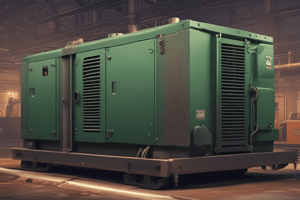Podcast
Questions and Answers
What is the purpose of the air intake system in a diesel power station?
What is the purpose of the air intake system in a diesel power station?
What is the function of the cooling system in a diesel power station?
What is the function of the cooling system in a diesel power station?
What is the purpose of the lubricating system in a diesel power station?
What is the purpose of the lubricating system in a diesel power station?
What type of generator is used in a diesel power station?
What type of generator is used in a diesel power station?
Signup and view all the answers
What is the function of the choke in an alternator excitation unit?
What is the function of the choke in an alternator excitation unit?
Signup and view all the answers
What is the purpose of a UPS (Uninterruptible Power Supply)?
What is the purpose of a UPS (Uninterruptible Power Supply)?
Signup and view all the answers
What is the process by which a UPS works?
What is the process by which a UPS works?
Signup and view all the answers
What is the purpose of the rectifier in a UPS?
What is the purpose of the rectifier in a UPS?
Signup and view all the answers
What is the primary factor to consider when sizing a UPS battery?
What is the primary factor to consider when sizing a UPS battery?
Signup and view all the answers
What is the purpose of considering redundancy in a UPS system?
What is the purpose of considering redundancy in a UPS system?
Signup and view all the answers
What is the main difference between Lead Acid/Calcium and Lead Acid/Calcium, Maintenance-free Gelled Electrolyte, Sealed Battery?
What is the main difference between Lead Acid/Calcium and Lead Acid/Calcium, Maintenance-free Gelled Electrolyte, Sealed Battery?
Signup and view all the answers
What should be considered when selecting a UPS topology?
What should be considered when selecting a UPS topology?
Signup and view all the answers
What is the purpose of evaluating the efficiency of a UPS?
What is the purpose of evaluating the efficiency of a UPS?
Signup and view all the answers
What should be considered when selecting a battery type?
What should be considered when selecting a battery type?
Signup and view all the answers
What is the purpose of considering the form factor of a UPS?
What is the purpose of considering the form factor of a UPS?
Signup and view all the answers
What should be evaluated when selecting battery banks?
What should be evaluated when selecting battery banks?
Signup and view all the answers
What is the primary function of the diesel engine in a diesel power station?
What is the primary function of the diesel engine in a diesel power station?
Signup and view all the answers
Why are diesel power stations used despite having a higher generation cost?
Why are diesel power stations used despite having a higher generation cost?
Signup and view all the answers
What is the primary function of a UPS?
What is the primary function of a UPS?
Signup and view all the answers
What is a major advantage of diesel power stations over steam power stations?
What is a major advantage of diesel power stations over steam power stations?
Signup and view all the answers
What is the main advantage of a UPS over other immediate power supply systems?
What is the main advantage of a UPS over other immediate power supply systems?
Signup and view all the answers
What is a disadvantage of diesel power stations?
What is a disadvantage of diesel power stations?
Signup and view all the answers
Where are diesel power stations often used as standby sets?
Where are diesel power stations often used as standby sets?
Signup and view all the answers
What is the purpose of a flywheel in a UPS?
What is the purpose of a flywheel in a UPS?
Signup and view all the answers
What is the transfer time of an Off-line UPS?
What is the transfer time of an Off-line UPS?
Signup and view all the answers
Why do diesel power stations occupy less space?
Why do diesel power stations occupy less space?
Signup and view all the answers
What is the main difference between an Off-line UPS and a Line Interactive UPS?
What is the main difference between an Off-line UPS and a Line Interactive UPS?
Signup and view all the answers
What is a characteristic of diesel power stations?
What is a characteristic of diesel power stations?
Signup and view all the answers
What is a limitation of diesel power stations?
What is a limitation of diesel power stations?
Signup and view all the answers
What is the purpose of the rectifier in an On-line UPS?
What is the purpose of the rectifier in an On-line UPS?
Signup and view all the answers
What is the advantage of an On-line UPS over an Off-line UPS?
What is the advantage of an On-line UPS over an Off-line UPS?
Signup and view all the answers
What is the purpose of the tap-changing transformer in a Line Interactive UPS?
What is the purpose of the tap-changing transformer in a Line Interactive UPS?
Signup and view all the answers
What is an important consideration when selecting battery banks?
What is an important consideration when selecting battery banks?
Signup and view all the answers
Why is it important to implement a battery monitoring system?
Why is it important to implement a battery monitoring system?
Signup and view all the answers
What is a key aspect of ensuring the reliability of the backup power system?
What is a key aspect of ensuring the reliability of the backup power system?
Signup and view all the answers
Why is it important to adhere to local codes and regulations?
Why is it important to adhere to local codes and regulations?
Signup and view all the answers
What is the purpose of developing a testing and maintenance schedule?
What is the purpose of developing a testing and maintenance schedule?
Signup and view all the answers
What is a recommended approach when selecting UPS and battery banks?
What is a recommended approach when selecting UPS and battery banks?
Signup and view all the answers
What is an important safety consideration when implementing a backup power system?
What is an important safety consideration when implementing a backup power system?
Signup and view all the answers
Why is it important to check the warranty provided by the battery manufacturer?
Why is it important to check the warranty provided by the battery manufacturer?
Signup and view all the answers
Study Notes
Diesel Power Station (DG Set)
- A generating station that uses a diesel engine as the prime mover for generating electrical energy.
- The diesel engine drives an alternator, which converts mechanical energy into electrical energy.
- Advantages:
- Simple design and layout
- Occupies less space
- Can be located anywhere
- Quick start-up and load pick-up
- No standby losses
- Less water required for cooling
- Lower overall cost compared to a steam power station of the same capacity
- Higher thermal efficiency
- Requires less operating staff
- Disadvantages:
- High running charges due to costly fuel (diesel)
- Unsatisfactory performance under overload conditions for a long period
- Limited to generating small power
- High cost of lubrication
- High maintenance charges
Schematic Arrangement of Diesel Power Station
- Auxiliaries:
- Fuel supply system
- Air intake system
- Exhaust system
- Cooling system
- Lubricating system
- Engine starting system
- Diesel generator set: a salient pole type synchronous generator, self-excited and self-regulated by an excitation unit
Uninterruptible Power Supply (UPS)
- A device that maintains a continuous supply of electrical power, even in the event of a mains (utility) supply failure.
- Installed between the mains supply and the equipment to be protected.
- Uses: safeguarding computers, data centers, and critical equipment in large organizations.
- Working principle:
- Converts mains AC supply to DC voltage
- Charges batteries during normal operation
- Uses DC voltage from batteries to supply power during a mains failure
- Converts DC voltage back to AC voltage using an inverter
- Advantages: immediate protection against input power interruptions, short battery run time, and safe shutdown of connected equipment
Types of UPS
- Off-line UPS (Standby UPS system):
- Primary source is the filtered AC mains
- Transfer switch selects the backup source during a power breakage
- Least expensive UPS system, provides surge protection and backup
- On-line UPS:
- Double conversion method: AC input is converted to DC for storage, and then converted back to AC for the load
- Used where electrical isolation is mandatory
- More expensive due to the design of constantly running converters and cooling systems
- Line Interactive UPS:
- Used for small business and departmental servers
- Similar to off-line UPS, but with the addition of a tap-changing transformer for voltage regulation
- Provides additional filtering and lower transient loss
Battery Types
- Lead Acid/Plante Battery
- Lead Acid/Antimony Battery
- Lead Acid/Calcium Battery
- Lead Acid/Calcium, Maintenance-free Liquid Electrolyte Battery
- Lead Acid/Calcium, Maintenance-free Gelled Electrolyte, Sealed Battery
- Lead Acid (Special Alloy), Suspended Electrolyte, Maintenance-free, Sealed Battery
- Nickel Cadmium, Pocket Plate Liquid Electrolyte Battery
Battery Sizing
- Manufacturers provide sizing information for their batteries
- Battery sizing is typically done using watts per cell or amperes per cell
- Watts per cell method: uses kilowatts per cell tabulated for various backup times
- Amperes per cell method: uses charts expressed in available amps for specified periods of time
Selection of UPS and Battery Banks
- Key considerations:
- Power capacity (kVA or kW)
- Topology (Online Double Conversion, Line Interactive, Standby)
- Redundancy
- Scalability
- Efficiency
- Compatibility
- Monitoring and management
- Form factor
- Battery type (VRLA, lithium-ion)
- Capacity and autonomy
- Charging time
- Temperature considerations
- Maintenance requirements
- Footprint
- Monitoring system
- Warranty
- Integration and compatibility
- Safety
- Testing and maintenance schedule
Studying That Suits You
Use AI to generate personalized quizzes and flashcards to suit your learning preferences.
Description
This quiz covers the basics of diesel power stations, also known as DG Sets, which use diesel engines as prime movers to generate electrical energy. Learn about the combustion process and how it produces mechanical energy.





